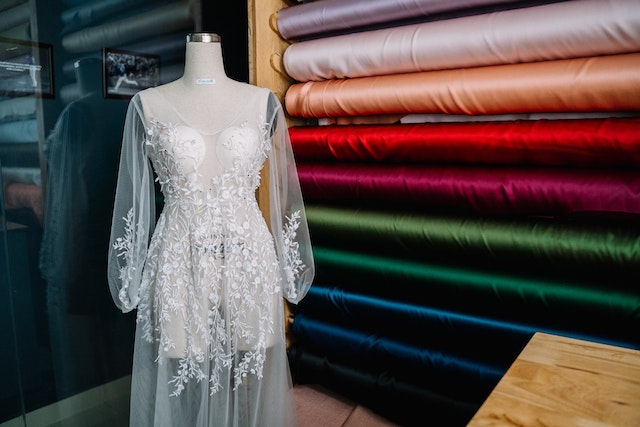
There are many different types of fabrics available, from natural materials to man-made alternatives. It helps to know a bit more about the type of fabric that you are choosing when you buy a new item of clothing, for instance, as some options are kinder to your skin and the environment than others.
When you buy a cotton T-shirt you know you are getting something natural that will feel comfortable and will last you well. This is just one type of fabric that you are probably familiar with, but how much do you know about all the different fabric types?
How it all starts
A good starting point for this guide would be to outline how the textile industry works when processing different fabric types.
You will find that cloth is a collective term used to describe the various materials and fabrics that are being used to produce the clothes we wear. The raw fibers being used are twisted together in order to create a thread. These threads are then knitted or woven to create a material that is then ready to be stitched and transformed into a garment.
These fibers can be either natural or synthetic in origin. A classic example of a natural fiber would be cotton, which is used extensively in the textile industry.
It is also commonplace to combine different fibers. That means you could buy a garment that is made from cotton and polyester, for example.
The label on each garment will tell you what fabric type has been used.
Different types of cotton
Standard cotton is commonplace but there are also other options to know about.
Organic cotton is grown in an eco-friendly way. This type of cotton is grown without using pesticides or fertilizers. It commands a higher price but this reflects the fact that it is produced in a way that is designed to have a modest impact on the environment.
Pima cotton is considered to be the finest strain and its premium quality is reflected in its price.
Supima cotton is actually a brand name. If you see a garment with this name on the fabric label you can be sure that the cotton has been exclusively grown in the USA. A defining feature of Supima cotton is that it has extra-long fibers. This adds increased softness and strength.
Polyester
Polyester came to prominence in the 1970s. It is a name that is a general term used to describe any fabric or textile that has been created using synthetic polymer yarns.
It is understandable why polyester became so popular as it is a fabric that is inexpensive to produce and offers good durability. It is not a sustainable fabric and is created using fossil fuels.
Jersey
This knitted fabric is commonly used to produce T-shirts. Although Jersey is often woven from cotton you will also find that it is made from a whole host of different synthetic fibers as well.
The name is synonymous with the island of Jersey and it started out being produced from wool, but its makeup has changed over time.
Cotton fleece
This fabric is very popular when it comes to the production of all sorts of casual wear such as hoodies and sweatshirts.
The reason why cotton fleece is so popular is this knitted fabric feels nice and soft on the inside and also offers good insulation.
Corduroy
This is a fabric that has a very long history. It came to prominence back in the 1700s when the French originally wove the material from silk. A century or so later corduroy was being woven from cotton and was being mass-produced to provide hard-wearing clothes for the working classes.
It has a very distinctive pattern and is still a popular choice if you want something that is casual, stylish, and robust.
Wool
Wool has been around for centuries and was one of the very first fibers that were spun into yarn before being woven into a fabric.
The majority of woolen garments produced originate from sheep and goats. However, it is not unusual to see wool produced from llamas, camels, and even some breeds of rabbits.
A major advantage of wool is that it is very resistant to wrinkling and will quickly return to its original shape even when it has been stretched.
Sherpa
You are most likely to see Sherpa used as a lining or as a garment trim. It can be made from acrylic, cotton, or polyester and the density of the material means it is great for providing insulation. This is why it is often used as a lining.
Satin
Satin is a fabric that is synonymous with luxury and decadence. It is a very smooth fabric that is lustrous in nature. It usually has a glossy and shiny surface with a duller surface on the reverse.
Satin earned its luxurious reputation as it was originally made from silk. Only the rich in society could afford it then. These days, satin is more widely available and you will find synthetic versions made from rayon or polyester.
Velvet
This is another fabric that is associated with luxury. It is interesting to note that the velvet description is a reference to the weave rather than the content of the material used.
It also started out as a material made from silk and destined for the upper classes. Thanks to modern manufacturing techniques and the fact that it is often woven from cotton, velvet is much more affordable.
Twill
You will find that Twill can be made from any fiber. This is because the term refers to the weave rather than its composition.
Twill has an unmistakable pattern consisting of diagonal ribs that run parallel.
Denim
Almost everyone seems to have a pair of denim jeans. Denim is a very durable twill fabric and is usually made from 100% cotton.
Nylon
Nylon was originally created as a viable substitute for silk. It is actually a generic term used to describe a range of synthetic polymers.
Linen
This natural fiber is created from the stalk of the flax plant. A distinctive feature of linen is that it is about a third stronger than cotton. It is also a very breathable fabric, making it popular in hotter climates.
All of these fabric types feature heavily in the world of garment manufacturing. Now you know a bit more about them it should help you choose the right one for your needs and preferences.


